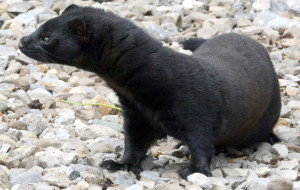Stratford Beacon Herald
 Canadian mink producers have upped the reward money for information leading to the arrest and conviction of those responsible for breaking into two St. Marys area farms over the last six weeks.
Canadian mink producers have upped the reward money for information leading to the arrest and conviction of those responsible for breaking into two St. Marys area farms over the last six weeks.
A reward of $75,000 was posted by the Canada Mink Breeders Association (CMBA) shortly after approximately 1,500 nursing females were released at Glenwood Fur Farm at the end of May.
The CMBA announced Tuesday that the reward has been increased to $100,000 and expanded to include the release of 6,000 young mink at nearby RBR Fur Farms sometime overnight July 7-8.
“The people who did this should be charged with animal cruelty,” said Gary Hazlewood, executive director of the CMBA, in a media release.
“Although many mink are being recovered, many may still become sick and die in the coming days because of the stress they have been subjected to. It’s despicable that anyone would make animals suffer in this way just to further their own political agenda.”
Hazlewood, a former mink farmer who lives near the two farms that were attacked, said it may be time for Canada to consider more serious penalties for people who invade farms for ideological purposes, as has been done in the United States.
Kirk Rankin, president of the CMBA and owner of the farm targeted in the most recent attack, said that the two-month-old farm-raised mink are not equipped to fend for themselves in the wild.
“These arrogant crusaders claim their criminal activity is justified by their opposition to using animals for any purpose, but their irresponsible action shows a shocking disregard for the welfare of both people and animals,” Rankin said. “We know there is a small segment of extremists who want to put us out of business, but, honestly, how could anyone be so ignorant or heartless as to release two-month old animals.”
In an interview last week shortly after the attack on Rankin’s farm, Will Hazlitt from the North American Animal Liberation Press Office said that the notion that fur farmers are concerned about the well-being of the animals is farcical.
“The mortality rate on a fur farm is 100% so if you release the animals into the wild of course some may die or not be able to fend for themselves,” Hazlitt said. “But if out of 100, 25 die and 75 survive that’s certainly an improved rate of mortality as opposed to the fur farm.”
Hazlitt said that while some within the animal rights community may not agree with releasing animals from farms, the Animal Liberation Front’s tactic, in conjunction with other strategies, has played a significant role in the progress that has been made in recognizing “that animals should be granted some minimal rights, at least to be free of exploitation and suffering.”
Calling the attacks “economic sabotage” by underground activists, Hazlitt acknowledged that mink farmers have been more frequent targets of animal rights supporters because they are “low-hanging fruit.”
“If it were possible to go to a cattle ranch and free 100,000 cattle, that would be something that would be done. But obviously that’s something that’s not possible. So these underground individuals take whatever action they can,” he said.
Fur farmers continue to point out that they are engaged in a legal activity in a free, democratic society.
“If you don’t want to wear fur, that’s fine, don’t buy it,” said Rankin. “But that doesn’t give you the right to dictate how everyone else should live; it doesn’t give you the right to break into people’s homes and terrorize farm families.”

